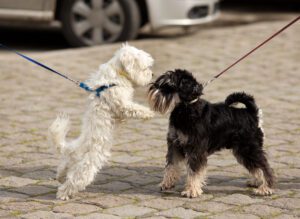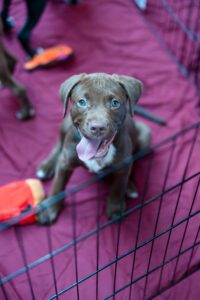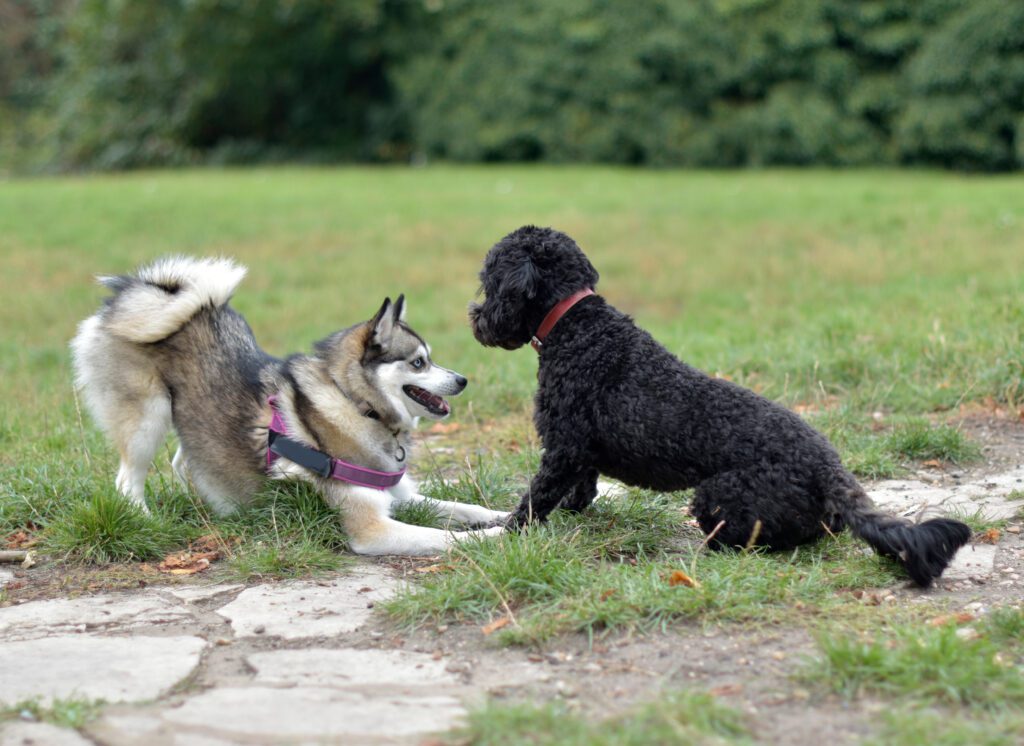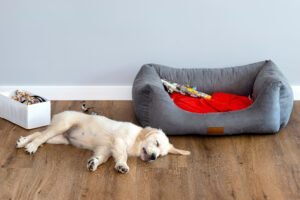What’s the only thing better than a dog? That’s right, two dogs! Owning multiple dogs can be beneficial to both you and your pets. However, while dogs are inherently social animals, simply putting two dogs into a room and expecting an instant friendship to form is not a good idea! Your dogs’ first few interactions will set the tone for their relationship. Let’s make sure to make that first impression a good one! Here’s how to introduce dogs with safety and comfort in mind.

Be Prepared
Before getting started, make sure that you have all the necessary supplies on hand. Have an exercise pen (also called x-pen), leashes and collars or harnesses for both dogs, and bite-sized, high-value treats. You will also need another person to help.

Just as important as what you do have is what you do not have in the vicinity. Resources such as food bowls or toys can potentially trigger resource-guarding. Learning to share can be a lesson for a later day. For now, focus on putting your dogs at ease!
Brush up on dog body language if needed. If your resident canine or newcomer is displaying signs of stress or anxiety, you should be able to recognize them and intervene to diffuse tensions. Stopping a situation early can mean the difference between ending on a high note or ending with an altercation.
Choose Your Meeting Place
If at all possible, have your resident dog and newcomer meet on neutral territory. Think of it this way – having a stranger, even a friendly one, burst into your home and announce that they are living there would be unsettling for even the most extroverted among us! By having them meet in a neutral place, you ensure that neither party feels that their home is being encroached upon right away.

The best place to start would be to have your dogs meet in an outdoor, open area such as a park or field. The primary exception to this would be introducing your dog to a very young puppy who has not yet had all of their shots. In this case, taking them out into public areas to walk around would be an inadvisable exposure. If you are bringing home one of our puppies, bringing your dog to the store for an initial meet-and-greet is an option for a neutral meeting ground. At the very least, try to at least begin introductions outdoors before moving into the home.
Build a Positive Association
Both dogs should be securely leashed. Each handler will be responsible for one dog, and each handler should have their own set of treats. Stand on opposite sides of the introduction area. The two handlers should walk their dogs in two parallel lines in the same direction. Reward them with treats when they behave calmly or look at the other dog then return their attention to their handler. If your dog stiffens up, becomes fixated on the other dog, or is overly excited in trying to reach the other dog, put more distance between the two and try again. If possible, try to keep the leashes loose as you walk to not introduce additional tension to the situation.

Once both dogs are relaxed and paying attention to the person that is walking them, handlers can move slightly closer to one another. Repeat this process until the humans can walk near to one another without the dogs becoming overly distracted by the other dog. At this point, the handlers can allow the dogs to sniff each other and then walk away after a few moments. Give your dog a reward after each sniffing session. If both dogs seem relaxed and happy, you’re ready to go inside.
Inside the Home
Set up an exercise pen for your new dog. Some people choose to introduce the new dog inside of a crate while the resident dog is outside, but we do not recommend this. Being in an enclosed space can make the new dog feel trapped and anxious. Instead, include the crate as part of the larger x-pen. This gives your new dog a private retreat that provides security rather than vulnerability.
If this is a young puppy unable to do an extended outdoor introduction, introducing them through the x-pen is an option.
In this case, you similarly want to build positive association by giving your dogs treats and praise while they can sniff and examine each other. If both dogs seem pleasantly interested in each other without incessantly trying to get at one another, you’re ready for some in home introductions.

Keep both dogs on a leash as you allow them to interact. Watch their body language carefully, and make sure that everyone is minding their manners! It is not unusual for older dogs to growl at young puppies if the puppy is being overly pushy or obnoxious. While this is normal boundary setting for the older dog, do intervene to avoid the situation escalating. Don’t forget to keep building that positive association with some treats every now and again!
Take Your Time
Becoming best friends is not instantaneous. Remember to give your dogs a break if they start to seem stressed or overstimulated. Adult dogs meeting puppies especially will need a break away from their new young friend. Puppies are excitable and they have very few boundaries, and this can be exhausting for an older dog! Always try to end a session on a high note.

Until you have seen your dogs interacting happily in a variety of circumstances, they should not be left together unsupervised. When you are finished with a session, make sure that the dogs are securely separated – and if either dog is a large one, be sure they cannot knock over the x-pen should the mood strike!
Every dog has their own personality that is shaped by their breed, experiences, and their own individual spark! For some dog pairings, this process may move smoothly. Other dog pairs may require several sessions on one step before moving onto the next. While this process may seem slow, remember that your dogs only get to make a first impression once. It’s up to us to facilitate it being the best first impression possible. Take your time and if ever your worry that you’re going too slow – go even slower. These initial weeks are short in comparison to the life these dogs will spend together. With any luck, these are the first steps to a beautiful lifelong friendship.

Still have questions? Here are some helpful videos on the subject. Also, just remember that our friendly puppy specialists are only a phone call away!



